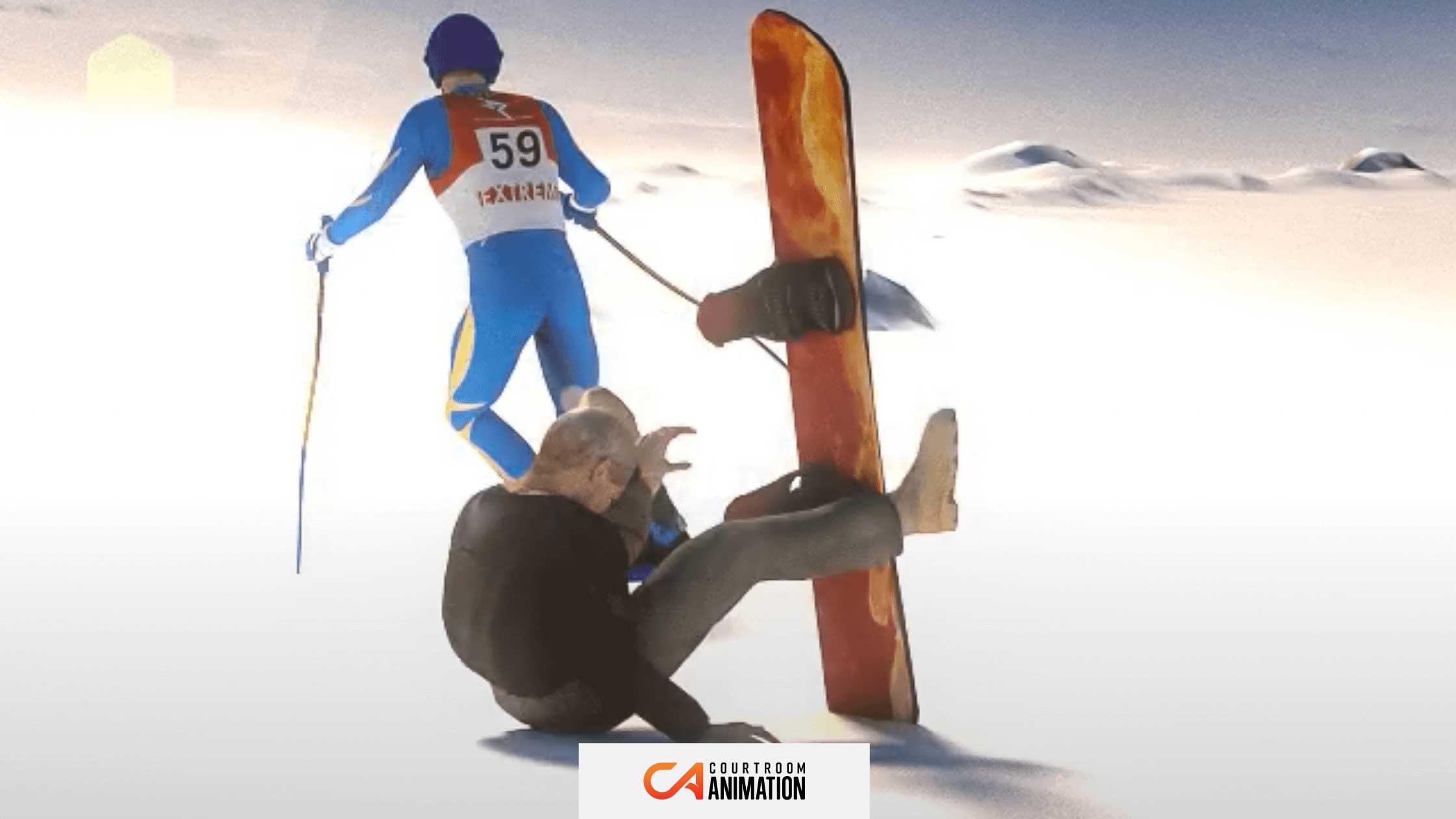
Visual litigation strategies have come a long way from the 1990s as technology has evolved — and part of that evolution stems from computer software improvements utilizing real-world physics. But how is physics implemented in 3D animation, and how does it benefit your case?
In this article, we’ll give you a crash course on the concept of physics, and help you understand how it’s used within legal animations.
The Two Types of Physics Simulations
In court animation, there are two central types of physics simulations: rigid body and soft-body simulators. In a rigid body simulation, objects are grouped into categories based on how they should interact and are less intense for the computer to calculate. Imagine a vehicle striking another vehicle, or a solid object like a wall.
Soft-body physics, on the other hand, involves simulating individual sections of each object so it behaves in a realistic way. Picture a vehicle hitting a human body; the simulation would calculate how each section of every limb would move in a particular direction.


Caption: Soft Body (Top Image) vs. Rigid Body (Bottom Image)
Physics simulations are crucial for creating realistic legal animations. Accurate animations need to visualize objects as they would behave in the real-world. Physics simulations ensure accuracy, which goes a long way with the admissibility of the animated trial exhibit.
Cassidy Curtis, a character animator for twenty years at DreamWorks, stated in a National Science Foundation course that:
“Physics is integral to everything we do as animators because when something doesn’t feel like it’s physically capable of happening, it pops the audience out of the moment. It reminds the audience that what they’re watching isn’t real.”
A realistic animation is one where the physics and data align — it is important not only to immerse your audience, but to ensure the admissibility of your exhibit. And so, just like the animations you see in the movies, physics are integral to your legal animations.
How Do Physics Impact Legal Animations?
Recreating a complex incident requires the ability to understand human movement and how it reacts to outside stimuli.
For example, think about what happens to the neck when it’s involved in a collision at 25 MPH. How is the whiplash different from a crash at 60 MPH?
A biomechanical engineer would be able to dictate the difference between these two crashes and how the body would move at different rates of travel or when struck by a different type of object. In the first ten seconds of the video below, you can see how the person’s body moves when hit by the vehicle.
Again, if the animation lacks realism your viewer, whether it be a juror or mediator, may immediately dismiss it as falsified and therefore unreliable. It will also remind the audience what they’re watching isn’t real and make them skeptical of your argument.
It is vital when choosing a forensic animation company that their quality of animation and the motion of objects is accurately depicted.
Importance of recreating body motion based on expert witness accounts, report data, etc.
There are a handful of case types that can involve a lot of complexity. Thus, the forensic animation’s physics must be highly precise:
- Officer Involved Incidents
- Example: Video evidence captured from body-mounted cameras showing a complex physical altercation.
- Product Liability Cases
- Example: A broken seat in a vehicle, failed seatbelts, or a failed airbag.
- Personal Injury Recreation
- Example: Taken from Dashcams, or any surveillance video.
How are Physics Incorporated into Visual Litigation?
Real world physics within the animation software allows the objects and people in your animation to be accurately represented.
In the absence of motion, a 3D model can depict any object. It could have the right dimensions and be in the right place at the right time, but any movement that’s added needs to be dictated by physics.
The “animation” in forensic science animation is the most engaging component of any visual exhibit. Depicting the motion and interactions between objects is often the crux in a visual litigation strategy. A neck snapping in a personal injury case, a dangerous maneuver in a car crash, a lethal blow in a physical altercation, or a fall in a slip and fall accident all require realistic motion.
Physical quantities that are important in a computer animation include:
- Velocity
- Mass of objects in collision
- Direction of objects
All of these forces are dictated by the expert witness, or by a hard piece of data, like a surveillance video. It’s the animator’s job to accurately portray that forensic animation data.
Want to learn more about what goes into a forensic animation’s creation? Download our free visual litigation eBook and read on the go!
Let’s use a car accident animation as an example — the accident reconstruction expert would simulate a car crash in a program such as PC Crash or HVE. These are industry standard computer programs that can integrate and share collision data to create realistic and convincing trial exhibits.
Once a simulation is finished, the accident reconstructionist can print a spreadsheet of data points that show where any object is at any given time at 100x per second. An animation team takes that motion data and plugs it into their animation software to apply motion to the realistic vehicles in the scene.
The underlying data, the hard science behind the collision, is put directly into the animation software. The animators then add a layer of realism that is expected in court, such as textures, lighting, camera perspectives, and more.
In short, your animation team takes all of the calculations and data, and turns it into a visual story for your client.
DATA VISUALIZATION SOLUTIONS FOR EVERY CASE
What is Match-Moving or Camera Tracking?
There are many questions revolving around video evidence and our trial animations in general. Here are some of the most common ones surrounding visual litigation:
- What data can be extrapolated from a video?
- What if I want to recreate a video and present it from different perspectives?
- How can you take measurements from a video?
A 3D animation exists in a computer-generated environment. That computer-generated world should match the REAL world, such as:
- Distances
- Heights
- Widths
- Positioning
- Or any other object measurements
Once you have that world, you create a computer-generated camera to match a real-world camera. This can mimic a surveillance camera, a police body mounted camera, a cell phone, etc.
Now, an animator can start overlaying them and ensure the movement of the person, car, or object moves the same way in the software as it would in the real world. That’s when they know it’s an accurate accident recreation.
And this is what match moving is — it’s the overlay of the two worlds and confirming the motion lines up from the camera’s perspectives. The prerequisites to this are an accurate, computer-generated world, and an accurate computer-generated camera. Camera tracking only makes sure the computer-generated camera moves the same as the real world one.
The power of these forensic animations is that there’s a lot of missing data in regular video evidence. It is often difficult to see the interactions of people and objects in surveillance footage, but once you have an accurate recreation, you can start to view things from an infinite number of perspectives giving you the power to take measurements and validate or invalidate any number of viewpoints.
This is helpful for viewers to better determine liability, as an attorney can argue what someone could have, or could not have, seen.
Why would a forensic animation company use match-moving?
It allows us to recreate a video accurately and show it in a user-friendly way, so that anyone can understand what happens.
For example, if a police officer had a body camera and wanted to show an alternate perspective in court, an animator could use match-moving techniques to recreate the exact scene in a software program.
Once physics (ie. movement) is added to the trial animation, then the attorney can show the desired perspectives to the jury or judge.
Physics Enhance the Compelling Animations For Your Case
Physics and visual litigation go hand in hand. The next time you have a complex case, remember that physics are created through real life measurements in animations, and thus are accurate and are classified as demonstrative evidence.
As computer software continues to evolve, the way we tell your client’s story through forensic animation will only become more impactful.
